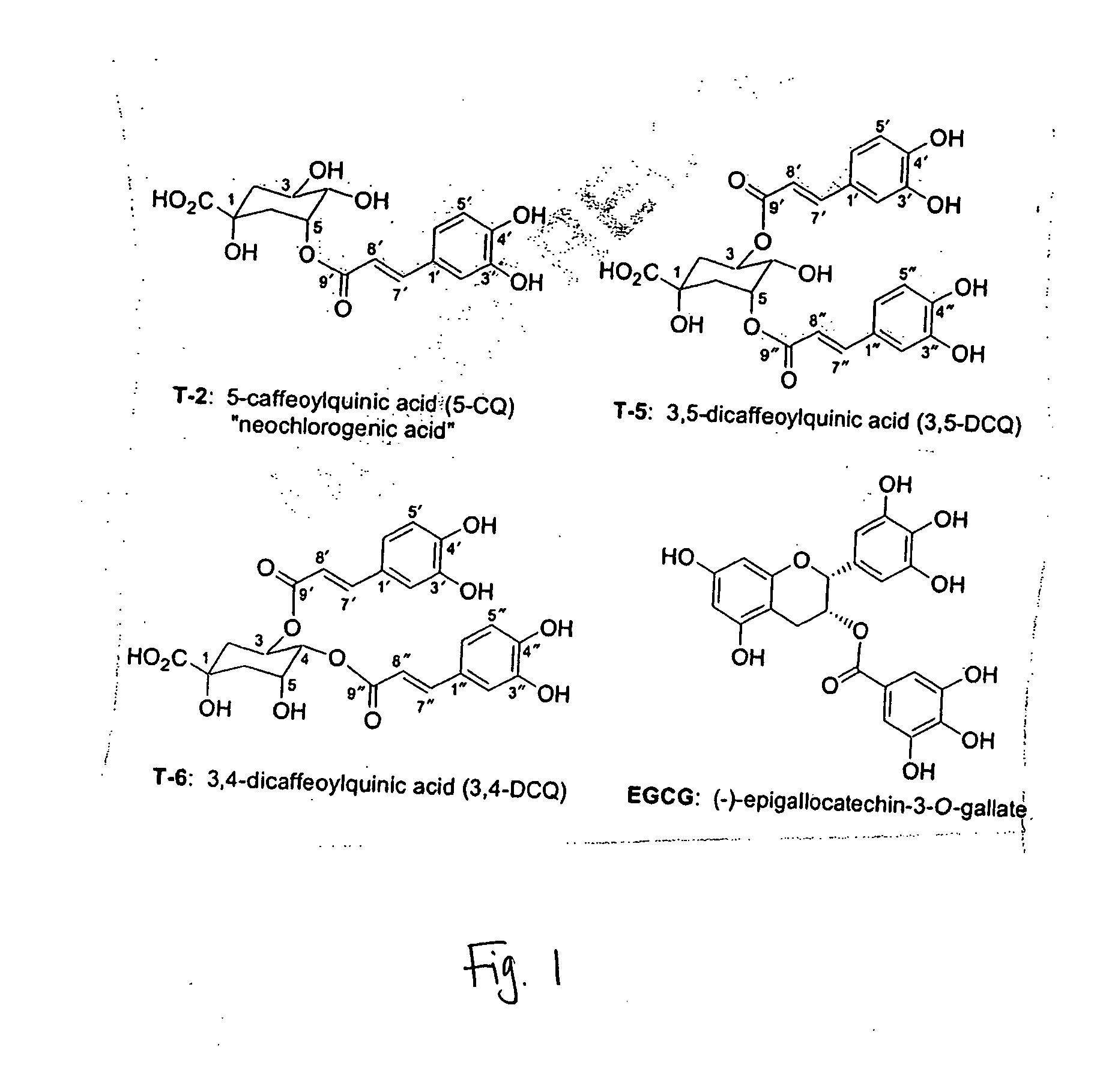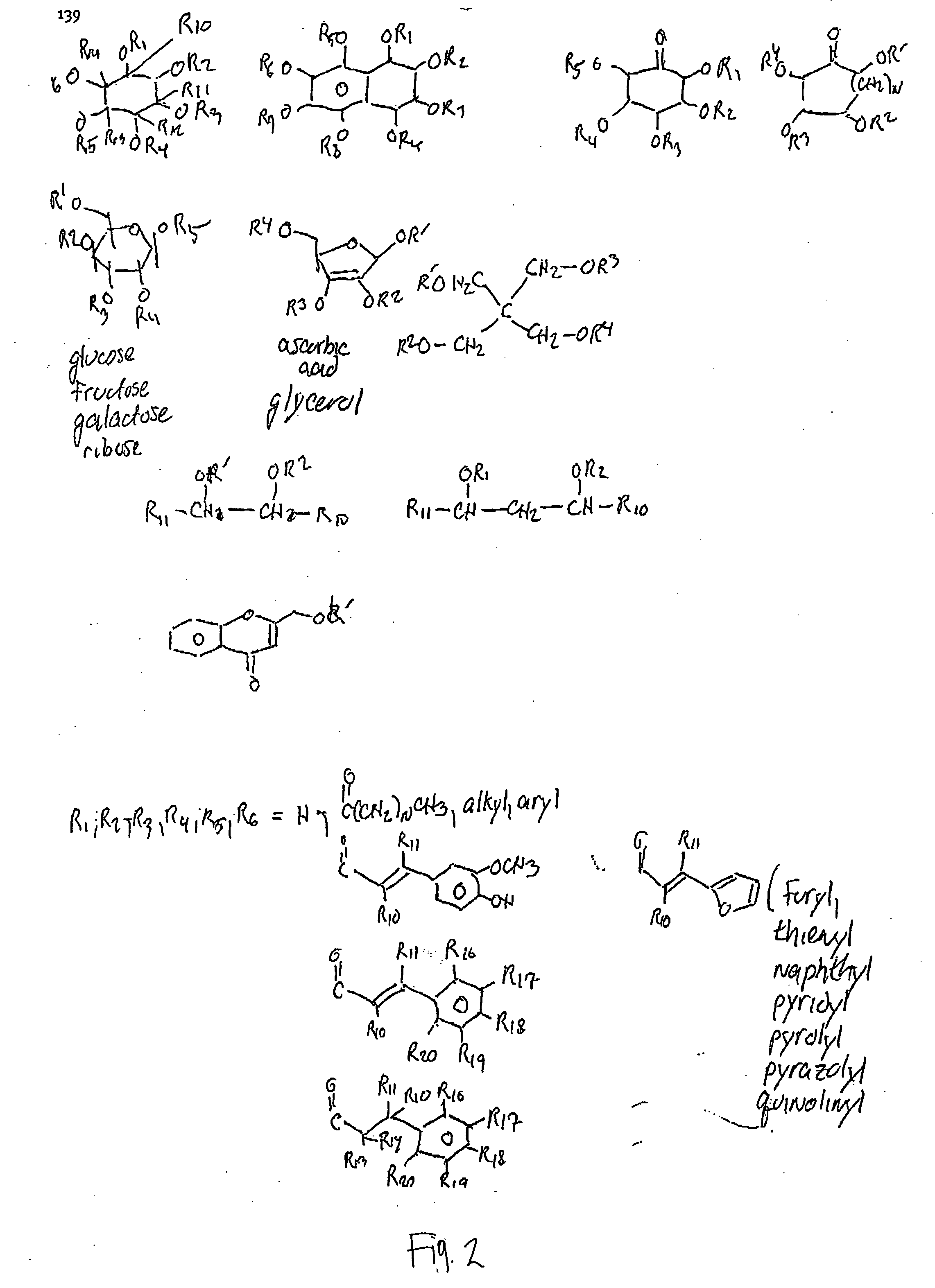Proteasome inhibitors and uses thereof
a proteasome inhibitor and inhibitor technology, applied in the field of skin disorders by proteasome modulation, can solve the problems of inability to treat similar diseases, inability to achieve similar treatments, and inability to achieve the effect of reducing the number of side effects
- Summary
- Abstract
- Description
- Claims
- Application Information
AI Technical Summary
Benefits of technology
Problems solved by technology
Method used
Image
Examples
example 1
Isolation and Characterization of Proteasome Inhibitors from Mate Tea
[0048] This example demonstrates the methods and materials required to isolate compounds with proteasome inhibition activity from mate tea and description of methods and assays to determine the effect of the isolated compounds.
(i) Preparation of Mate Tea Extracts
[0049] Powdered mate tea (Chimarrao Laranjeiras Puraerva, Cascavel, Brazil). Mate tea (100 g) was extracted by boiling in 500 ml water for 30 minutes. Pentaerythritol tetrakis (3,5-di-tert-butyl-4-hydroxyhydrocinnamate) (PTTC) was obtained from Aldrich Chemical Co (St Louis, Mo.). Once cool, the crude aqueous extract was first filtered through a 0.45 micron filter and further filtered to exclude materials of greater than 3000 MW.
[0050] The filtered aqueous extract was lyophilized to a dry powder, which was dissolved in distilled water and analyzed by HPLC, and 5 fractions were collected. HPLC fractions were lyophilized. Each fraction was reconstituted ...
example 2
Inhibition of Purified 20S Proteasome Activity by HPLC-Purified Mate Tea Fractions
[0057] This example describes the how to analyze the inhibitory effect of isolated fractions of mate tea in vitro, using purified 20S proteasome. The chymotrypsin-like activity of purified 20S proteasome was measured as previously described (Nam et al., (2001) J. Biol. Chem. 276, 13322-13330). Briefly, purified prokaryotic 20S proteasome (0.5 μg) was incubated with 20 μM fluorogenic peptide substrate, Suc-Leu-Leu-Val-Tyr-AMC for 30 min at 37° C. in 100 μl of assay buffer (50 mM Tris-HCl, pH 7.5), with or without a mate tea fraction at indicated concentrations. After incubation, production of hydrolyzed 7-amido-4-methyl-coumarin (AMC) groups was measured using a multi-well plate VersaFluor™ Fluorometer with an excitation filter of 380 nm and an emission filter of 460 nm (Bio-Rad).
[0058] The quinic acid esters resemble the proteasome inhibitor (−)-epigallocatechin gallate [(−)-EGCG] in that they contai...
example 3
Inhibition of Proteasome Activity in Jurkat T Cell Extracts by HPLC-Purified Mate Tea Fractions
[0060] This example describes the how to analyze the inhibitory effect of isolated fractions of mate tea in vivo, using cell extracts of the Jurkat cancer cell line. Whole cell extracts (20 μg) of Jurkat T cells were incubated for 60 min at 37° C. with 20 μM of fluorogenic peptide substrate Suc-Leu-Leu-Val-Tyr-AMC in 100 ml of the assay buffer, with or without a mate tea fraction at indicated concentrations. The hydrolyzed AMCs were quantified as described above.
[0061] The abilities of 3,5-DCQ and neochlorogenic acid to inhibit the 26S proteasome activity in Jurkat cell extracts was tested. The results show that 3,5-DCQ at 20 μg / ml (37 μM) inhibited the proteasome activity by ˜50%, and at 100 μg / ml (183 μM) inhibited the proteasome activity by ˜85%, which was almost as potent as 100 μM EGCG. In this assay, neochlorogenic acid (5-CQ) was also able inhibit the proteasome activity (˜30% at ...
PUM
| Property | Measurement | Unit |
|---|---|---|
| concentration | aaaaa | aaaaa |
| downfield chemical shifts | aaaaa | aaaaa |
| pH | aaaaa | aaaaa |
Abstract
Description
Claims
Application Information
 Login to View More
Login to View More - R&D
- Intellectual Property
- Life Sciences
- Materials
- Tech Scout
- Unparalleled Data Quality
- Higher Quality Content
- 60% Fewer Hallucinations
Browse by: Latest US Patents, China's latest patents, Technical Efficacy Thesaurus, Application Domain, Technology Topic, Popular Technical Reports.
© 2025 PatSnap. All rights reserved.Legal|Privacy policy|Modern Slavery Act Transparency Statement|Sitemap|About US| Contact US: help@patsnap.com



